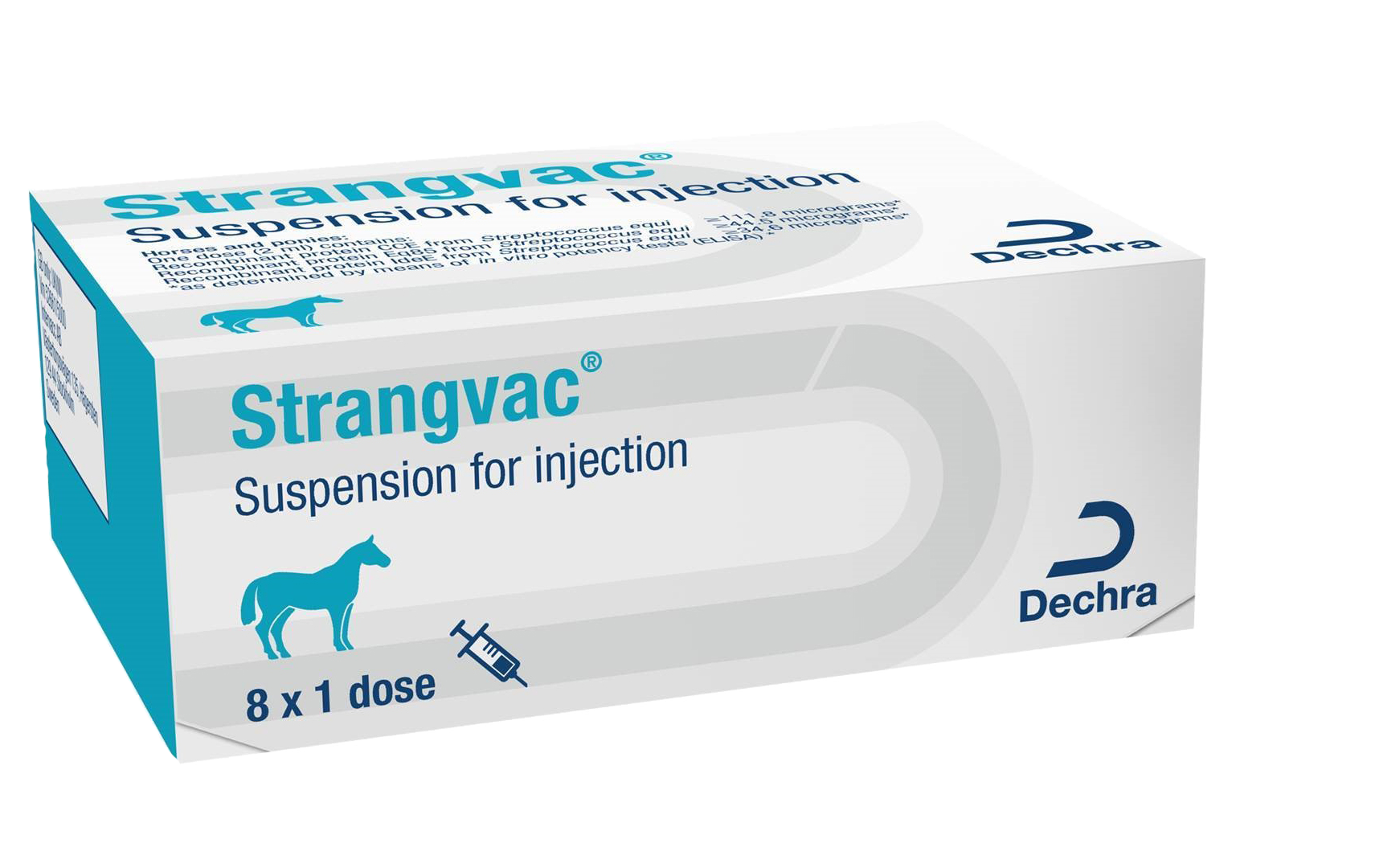DNA fragments encoding eight important Streptococcus. equi (Strep. equi) proteins are joined together to make three synthetic ‘genes’. Each fused protein gene is placed into Escherichia. coli (E. coli) bacteria. The E. coli is grown in fermenter cultures and uses the synthetic genes as a blueprint to make each protein. The fermented E. coli is then lysed and each protein is extracted and purified – ready for use in Strangvac. It is key to note that Strangvac contains no Strep. equi bacteria nor DNA, and as a consequence, has DIVA capability.
What is Strangvac?
Strangvac is an intramuscular vaccine against the highly contagious respiratory disease strangles.
Strangvac is indicated to reduce the clinical signs and the number of abscesses within submandibular
and retropharyngeal lymph nodes in horses during the acute stage of strangles.
Which technology is used in Strangvac?
Strangvac uses innovative recombinant fusion protein technology add
Which Strep. equi antigens are included in Strangvac? add
Strangvac contains the following proteins:
- Recombinant protein CCE, comprised of Strep. equi antigens: CNE, SclF, SclI, SclC and EAG
- Recombinant protein Eq85, comprised of Strep. equi antigens: Eq5 and Eq8
- Recombinant protein IdeE, comprised of Strep. equi antigen IdeE
These antigens, with the exception of IdeE, are localized on the bacterial surface. Antibodies against them are assumed to be opsonic and block bacterial adherence to tissue surfaces, while they also block the ability of these important proteins to help Strep. equi to cause disease.
The seven cell wall proteins are surface-anchored to the peptidoglycan bacterial cell wall. CNE binds collagen1 and Strangvac responses block the attachment of Strep. equi to collagen.2 EAG binds alpha 2-macroglobulin, serum albumin and IgG.3, 4 The functions of SclF, SclI, SclC, Eq5 and Eq8 are currently unknown, but are likely to not only be involved in adhesion, as many of these classes of proteins have multiple functions in misdirecting host immune responses.
Interestingly, SclF, SclI, SclC and Eq8 are each individually essential to Strep. equi, in order for it to cause strangles in horses.5 Therefore, the immune responses generated by Strangvac target Strep. equi for killing, but they also block key virulence functions, making it easier for the immune response to kill Strep. equi.
IdeE cleaves immunoglobulin produced by the horse in response to Strep. equi infection. The immune responses to Strangvac neutralise the activity of IdeE so that the horse’s immune system can more effectively target and kill Strep. equi.8
Does Strangvac protect against all field strains of Strep. equi? add
The antigens in Strangvac are extremely well conserved and Strangvac is expected to protect against all variants of Strep. equi. that currently circulate worldwide. All 759 strains examined in a survey had at least six identical antigens to the eight in Strangvac.6
98% of strains had none or only one amino acid variation relative to the 1,580 amino acids that make up the eight antigens in Strangvac. Strangvac is based on the BAPS2 strain (the most prevalent cause of strangles in Europe), and the studies that determined the effectiveness of Strangvac used a heterologous BAPS5 strain, which is the second most prevalent type of Strep. equi in Europe.
If you are interested in hearing more about how well conserved the Strangvac antigens are across field isolates of Strep. equi, please visit Dechra Academy, where you will find a recording of Dr. Frosth’s presentation from the IEIDC congress 2021
Will a Strangvac-vaccinated horse test positive for strangles? add
No, Strangvac does not contain live Strep. equi or Strep. equi DNA. Therefore, horses that have been vaccinated with Strangvac will not test positive for strangles in diagnostic culture or PCR tests, unless they have been recently infected with Strep. equi.
In addition, Strangvac does not contain the proteins used in the strangles blood tests, so vaccinated horses will not test seropositive unless they have been exposed to Strep. equi.
This means that Strangvac, unlike other strangles vaccines, possesses DIVA capability (DIVA = Differentiating Infected from Vaccinated Animals).
When is onset of immunity achieved?
The onset of immunity is two weeks after the second vaccination dose, with the second vaccination administered four weeks after the first vaccination.

How long is the duration of immunity?
After the primary course of two vaccinations, the duration of immunity has been shown to last for two months.

Is Strangvac well tolerated?
Testing has found that Strangvac is well tolerated in horses from the age of five months.
Strangvac does NOT contain live bacteria, and therefore cannot cause strangles, as has been reported with the use of live vaccines.12, 13
Study: “Which adverse reactions can be seen after vaccination with Strangvac”

Primary vaccination course
First vaccination: from five months of age
Second vaccination: four weeks later

Re-vaccination
In horses at high risk of Strep. equi infections, it is recommended to repeat the primary vaccination course after two months. Data for prolonged clinical protection from the administration of single-dose revaccinations are currently not available.
Based on measured antibody titers immunological memory response was found in horses following repeated vaccination six months after primary vaccination. The role of the measured antibodies in the immune response relevant for the protection against strangles is not known.

FAQ’s
Which horses can be vaccinated? add
The vaccine is tested safe for use in horses from the age of five months. Vaccination is highly recommended for:
- Young horses from five months of age
- Horses before competition, sales or possible exposure, such as equine events
- Horses in an area with known outbreaks of strangles
The safety of the product has not yet been tested in pregnant mares and breeding stallions.
Can I combine Strangvac with other vaccines? add
No information is available on the safety and efficacy of this vaccine when used with
any other veterinary medicinal product.
A decision to use this vaccine before or after any other veterinary medicinal product therefore needs to be made on a case by case basis.
Should I vaccinate in an outbreak situation? add
This is not yet tested, but there are some guidelines:
- Horses with clinical signs and those in contact should NOT be vaccinated
- Vaccinated horses that have not been in contact with cases:
- Last dose >2 months: it is recommended to repeat the primary vaccination course
- Last dose <2 months: no booster required
- Unvaccinated horses
- Start primary course: partial protection from two weeks after second dose
Should I vaccinate young, old or non-competition horses? add
Young and old horses are at the highest risk of severe disease if they become infected with Strep. equi.
Vaccination will reduce the clinical signs and the number of abscesses in these susceptible horses.
Can a vaccinated horse become infected? add
Efficacy has been demonstrated for the individual horse to reduce clinical signs of disease in the acute stage of the infection. Vaccinated horses can still be infected and shed Strep. equi.
How to administer and store Strangvac? add
- Administer one dose (2 ml) by intramuscular injection
- Store and transport refrigerated (2°C to 8°C), but do not freeze
- Keep the vial in the outer carton in order to protect from light
Keen to learn more about strangles and vaccination?
Please visit Dechra Academy for a series of interesting presentations on the subjects.

Strangles’ diagnosis, control and vaccination by Andrew Waller;
Conservation of antigen sequences across a global population of Strep. equi by Sara Frosth
Functional activities of antibody responses following vaccination of ponies with a multicomponent subunit vaccine against strangles by Francesco Righetti.
Click here to view the comprehensive module with all three presentations
Contact us!
Address:
e-mail:
Phone:

References add
-
Lannergard J, Frykberg L, Guss B. CNE, a collagen-binding protein of Streptococcus equi. FEMS Microbiol Lett. 2003 May 16;222(1):69-74. doi:10.1016/S0378-1097(03)00222-2
-
Flock et al., unpublished data
-
Jonsson H, Lindmark H, Guss B. A protein G-related cell surface protein in Streptococcus zooepidemicus. Infect Immun. 1995 Aug;63(8):2968-75. doi:10.1128/IAI.63.8.2968-2975.1995
-
Lindmark H, Jonsson P, Engvall E, Guss B. Pulsed-field gel electrophoresis and distribution of the genes zag and fnz in isolates of Streptococcus equi. Res Vet Sci. 1999 Apr;66(2):93-9. doi:10.1053/rvsc.1998.0250
-
Charbonneau. Barcoded Transposon Directed Insertion-site Sequencing (TraDIS); a tool to improve our understanding of the functional genomics of Streptococcus equi subsp. equi. Thesis University of Cambridge, 2018.
-
Frosth S, McGlennon A, Wilson H, et al. Conservation of antigen sequences across a global population of Streptococcus equi. Equine Vet J, 2021; 53, Suppl 56: 21.
-
Robinson C, Waller AS, Frykberg L et al. Intramuscular vaccination with Strangvac is safe and induces protection against equine strangles caused by Streptococcus equi, Vaccine 2020 Jun 26;38(31):4861-4868. doi: 10.1016/j.vaccine.2020.05.046.
-
Righetti F, Hentrich K, Flock M, et al. Functional activities of antibody responses following vaccination of ponies with a multicomponent subunit vaccine against strangles. Equine Vet J, 2021; 53, Suppl. 56: 26.
-
Lannergard J., Guss B. IdeE, an IgG-endopeptidase of Streptococcus equi ssp. equi. FEMS Microbiol Lett 2006 Sep;262(2), 230-235. doi: 10.1111/j.1574-6968.2006.00404.x.
-
Hulting G., Flock M., Frykberg L, et al. Two novel IgG endopeptidases of Streptococcus equi. FEMS Microbiol Lett 2009 Sep; 298(1), 44-50. doi: 10.1111/j.1574-6968.2009.01698.x.
-
Guss B, Flock M, Frykberg L, et al. Getting to grips with strangles: an effective multi-component recombinant vaccine for the protection of horses from Streptococcus equi infection. PLoS Pathog. 2009 Sep;5(9):e1000584. doi: 10.1371/journal.ppat.1000584.
-
Kemp-Symonds J, Kemble T, Waller A. Modified live Streptococcus equi ('strangles') vaccination followed by clinically adverse reactions associated with bacterial replication. Equine Vet J. 2007 May;39(3):284-6. doi:10.2746/042516407x195961
-
Livengood J, Lanka S, Maddox C, Tewari D. Detection and differentiation of wild-type and a vaccine strain of Streptococcus equi ssp. equi using pyrosequencing. Vaccine 2016 Jul 25;34(34):3935-7.doi: 10.1016/j.vaccine.2016.06.035.







